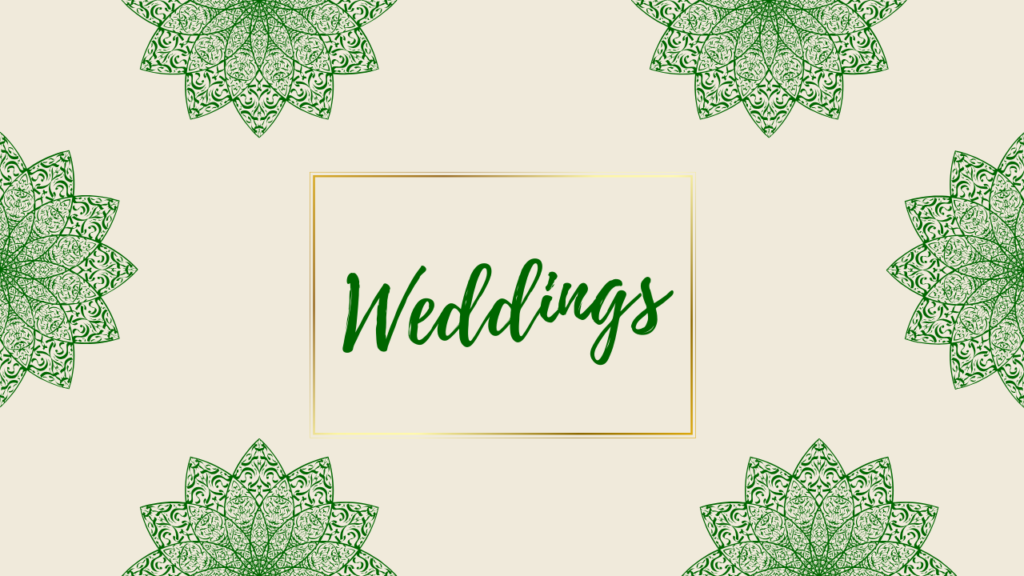WEDDINGS
The Timeless Magic of Weddings: A Celebration of Love, Tradition, and Style Weddings are among the most significant and beautiful occasions in our lives. They mark the beginning of a new chapter for couples, a day when love, culture, and tradition converge in a spectacular celebration. From the moment a couple exchanges vows to the joyful celebration with family and friends, a wedding encompasses not only a commitment between two individuals but also a profound reflection of family heritage, societal values, and personal expression. Over the years, weddings have evolved from simple ceremonies to grand affairs that are often planned for months, sometimes years, with an emphasis on perfection in every detail. Weddings bring together traditions, modern trends, and an expression of the couple’s personality, making each one unique. This article will explore the rich history of weddings, the evolution of wedding trends, cultural influences, and the timeless significance of these celebrations. 1. The History of Weddings: From Ancient Traditions to Modern Celebrations The concept of marriage and weddings dates back thousands of years, with the origins and traditions rooted deeply in cultural, religious, and social practices. The act of marriage was originally designed to forge alliances, both for economic purposes and for the security of the family unit. Early Beginnings of Weddings: Ancient Civilizations In ancient civilizations, weddings were often considered an essential part of maintaining social order. In Mesopotamia, ancient Greeks, and Rome, weddings were formalized through legal contracts between families, and often included the exchange of goods or dowries. These early weddings were less about romance and more about uniting families and ensuring the stability of the society. In ancient Egypt, marriage was seen as a natural union, but ceremonies were not elaborate. Brides wore simple linen dresses, and ceremonies took place within the confines of a family’s home. Ancient Egyptians also practiced the tradition of exchanging rings, which symbolized the eternal nature of marriage, as they believed that the ring’s circular shape had no beginning or end. Ancient Greek and Roman weddings were more celebratory. For example, Roman brides wore a veil as a symbol of modesty and protection, and the bride was often accompanied by a procession to the groom’s home. The wedding feast was an essential part of the day, and guests would offer blessings and gifts to the couple. The Influence of Religion on Weddings The arrival of Christianity had a significant impact on the institution of marriage in Western societies. By the Middle Ages, weddings had become religious ceremonies held in churches. The Christian church’s influence elevated marriage to the status of a sacrament, signifying a spiritual union as well as a legal one. The marriage vows began to be exchanged in front of clergy, and couples were expected to enter into marriage in the presence of witnesses, signifying the sanctity of the union before God. In many cultures, marriage was regarded as a sacred union that was closely tied to faith. For example, in Hinduism, weddings are deeply spiritual and often take place over several days, with various rituals and ceremonies performed to ensure the couple’s bond is blessed by the gods. The tradition of white wedding dresses, popularized by Queen Victoria’s wedding in 1840, also became an iconic element of Western weddings, symbolizing purity and new beginnings. 2. The Evolution of Wedding Traditions Over the centuries, wedding traditions evolved, reflecting changing societal values, economic conditions, and cultural exchanges. As the centuries progressed, weddings transitioned from small family gatherings to grand, lavish affairs. Victorian and Edwardian Weddings: A Shift in Fashion and Formality In the Victorian era, weddings became more elaborate, with emphasis on formality and sophistication. Queen Victoria’s choice of a white wedding dress set the tone for future brides, and soon, brides across England and the United States were following her lead, opting for white or off-white gowns to symbolize purity. The use of lace, silk, and satin made wedding gowns a high-fashion item, and the dress became the centerpiece of the bride’s attire. The Edwardian era saw the rise of more ornate and extravagant weddings, with increasingly expensive receptions, grand venues, and elaborate floral arrangements. The wedding cake, too, became more symbolic, often featuring multiple tiers and intricate decorations to signify wealth and good fortune. The 20th Century: Weddings in the Roaring Twenties and Beyond The Roaring Twenties brought about significant social change, with many young people questioning traditional values. The concept of “love marriages” became more widespread, and couples began to have more agency in choosing their life partners. Wedding celebrations, however, remained formal affairs, often taking place in churches or grand ballrooms. By the mid-20th century, weddings were becoming larger and more extravagant, particularly in post-World War II society. The “traditional” wedding ceremony, with a white gown, tuxedos, and a formal reception, became an iconic template for many. Celebrities like Grace Kelly, Elizabeth Taylor, and Marilyn Monroe showcased their own wedding extravaganzas, influencing popular culture and inspiring trends that lasted for decades. The 1960s and 1970s saw the rise of counterculture movements, which led to more relaxed, informal wedding celebrations. Outdoor weddings, beach weddings, and smaller ceremonies became more common, reflecting the changing ideals of love and commitment. In recent decades, weddings have become increasingly personalized. Couples now prioritize authenticity, aiming to make their day an expression of who they are rather than strictly adhering to traditional expectations. From unique wedding themes to DIY decor and custom-made gowns, modern weddings are as much about self-expression as they are about ceremony. 3. Wedding Customs and Traditions Around the World While weddings in the Western world often follow similar trends, wedding customs vary widely across the globe. Each culture celebrates marriage in its own way, blending ancient rituals with modern influences. Indian Weddings: A Multiday Extravaganza Indian weddings are known for their vibrant and festive nature. These weddings, which can last up to several days, involve a series of elaborate rituals and ceremonies, such as the mehendi (henna ceremony), sangeet (a celebration with music and dance), and



